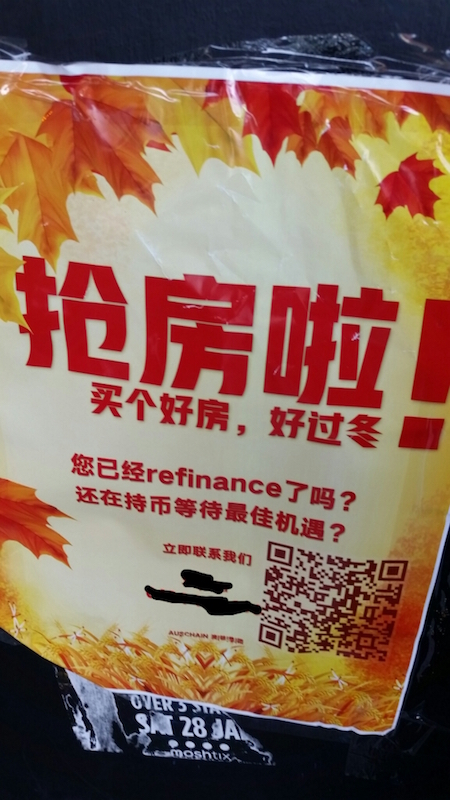Biscriptal juxtaposition in Chinese, part 3
« previous post | next post »
Christopher Alderton saw this flyer on his way to work a few days ago:
The big, bold characters at the top exhort:
Qiǎng fáng la 抢房啦! ("Grab a house!")
What's most arresting is this line:
nín yǐjīng refinance le ma?
您已经refinance了吗?
"Have you already refinanced?
Christopher rightly points out that the meaning of the construction "已refinance了" is sufficiently clear, but it is striking that the English word is not inflected, and the inflection is instead conveyed by the aspect marker of completed action, -le 了.
It's hard to tell exactly why the person responsible for this advertisement decided to use an English word in the middle of a Chinese sentence. To more readily catch the attention of potential customers? Because there's not a precise equivalent available in Mandarin?
The next line reads:
hái zài chí bì děngdài zuì jiā jīyù?
还在持币等待最佳机遇?
"Are you holding cash waiting for the best opportunity?"
Whatever the reason for inserting that English word in the middle of a Chinese sentence, one thing is certain: Àoliàn tóuzī 澳链投资 ("AUSCHAIN") wants you to snap up one of their houses pronto!
We've looked at examples of multiscriptalism and / or multilingualism involving many languages and scripts. Here are some posts specifically involving Chinese:
- "Biscriptal juxtaposition in Chinese, part 2" (10/15/14)
- "Biscriptal juxtaposition in Chinese" (8/17/14)
- "A New Morpheme in Mandarin" (4/26/11)
- "Zhao C: a Man Who Lost His Name" (2/27/09)
- "Creeping Romanization in Chinese" (8/30/12)
- "A trilingual, biscriptal note (with emoji)" (2/5/17)
- "Digraphia and intentional miswriting" (3/12/15)
- "Character amnesia and the emergence of digraphia" (9/25/13)
And there are many others.
[Thanks to Melvin Lee, Fangyi Cheng, Yixue Yang, and Jinyi Cai]

Thomas Rees said,
April 24, 2017 @ 6:59 pm
Did Christopher Alderton see the flyer in Australia? Apparently Auschain Investment Group is based in Sydney, but its website is in Chinese. Are they targeting Overseas Chinese or China residents looking to park funds abroad?
Chris Alderton said,
April 24, 2017 @ 8:57 pm
Hi Thomas,
I saw the flyer in Sydney, and based on the current state of the housing market I would say that the answer is "A little from column A, and a little from column B". There's both a lot of Chinese expats living in Sydney and a lot of interest in the property market from foreign investors.
Thanks to you, Professor Mair, for the post.
Endymion Wilkinson said,
April 24, 2017 @ 8:58 pm
One problem of writing with biscriptal juxtaposition (a problem illustrated by the flyer quoted by Christopher) is that because Chinese is written as a partial scriptio continua (no space between words), if you switch to English text in the same line or paragraph you have to manually insert a space after the last character (and before each character if you switch from English to Chinese in the same line); (2) to enable justification of Chinese characters all Chinese punctuation marks are followed by an inflexible space equal to the width of one character. This creates havoc with your word processor’s word spacing algorithm if you are combining text in the two languages.
Has anybody found a work-around for this?
Phil Jennings said,
April 24, 2017 @ 10:22 pm
I'm eating from a bag of spicy south Indian snacks with a similar color scheme. I can't see how it's congruent with real estate investment. Flame colors and real estate don't go together. Or is that just my cultural bias?
Daniel said,
April 24, 2017 @ 10:42 pm
@Endymion Wilkinson
I don't fully understand your dilemma, but if justification is important, I choose monospaced fonts for English.
@Phil Jennings
I guess flame colours and fall colours go together. Or do they really in Australia? Are maple leaves that common that it would be used in an ad there?
liuyao said,
April 24, 2017 @ 11:56 pm
There may be an equivalent in Mandarin (重新贷款 after some googling), but this being in Sydney, the potential buyer would be refinancing with an Australian bank, so it makes sense to use English. Even with a Mandarin-speaking agent, they'd probably mix English technical words in an otherwise Chinese sentence.
David Marjanović said,
April 25, 2017 @ 9:04 am
David Marjanović said,
April 25, 2017 @ 9:05 am
Blockuqote!!!
Jonathan Smith said,
April 25, 2017 @ 9:56 am
Interesting; use of the plain verb in such cases ("您已经refinance了吗?") seems to be "how it's done" in code-switching speech. Maybe less regular verbs exhibit exceptional behavior though?
As a language teacher, "抢房啦" smells like an opportunity to be extra-picky about 了, but perhaps no translation is both succinct and rigorous. "Snatching houses has commenced [and you should join in]!", "[we are all/everyone else is] now snatching houses!", etc., are poor. :/ "Time to snatch a house!" maybe?
B.Ma said,
April 25, 2017 @ 8:02 pm
The autumn motif of the flyer appears to be confusing some commenters, perhaps because Victor omitted typing out one of the lines of text (under the headline):
买个好房,好过冬 – buy a nice house [in order to] have a good winter / better get through the winter
Jonathan D said,
April 25, 2017 @ 9:38 pm
Daniel, you're right that deciduous trees are much less common in Sydney than some parts of the world. That doesn't mean there is no cultural association imported (along with some trees themselves) from other parts of the world, though – for Sydneysiders in general, and perhaps particularly for the intended audience of this flyer.